LIGER
A Next Generation Keck AO Instrument

Liger is a near-infrared integral field spectrograph (IFS) for the W. M. Keck Observatory. It will use the upcoming Keck All-Precision Adaptive optics (KAPA) system on the Keck I telescope with performance and advancements for large format near-infrared detectors. Liger is based largely on the design of IRIS for the forthcoming Thirty Meter Telescope (TMT). This will minimize costs and fabrication and construction timescales.
The Liger instrument uses the latest near-infrared detectors for an imaging camera that operates simultaneously with an innovative IFS that uses both a slicer and lenslet array for spatial sampling. It will help explore a wide range of science cases including dark matter substructure, distant galaxies, supermassive black holes, nearby star forming regions, the Galactic Center, and Solar System bodies. It will enable new science by offering enhanced capabilities such as higher spectral resolving power (R∼8000-10000), access to shorter wavelengths (0.84 - 2.4 µm), and larger fields of view compared to any current and future ground- and space-based IFS systems.
Liger is a crucial stepping stone both technologically and scientifically for the next decade in astronomy.
Science Drivers for New Capabilities of Liger
| New Capability of Liger | Main Science Driver |
|---|---|
| Extending to higher spectral resolution (R > 8000-10,000) | Supermassive and intermediate-mass black hole measurements; high-z galaxy kinematics; planetary and stellar atmospheres and abundance patterns; radial velocity measurements |
| Extending to visible wavelengths (λ < 1 μm) | Dynamics and abundances in a range of systems; solar system bodies; exoplanet metallicities; accretion diagnostics in young stars and planets; low-z galaxies; black hole mass measurements |
| Larger IFS field of view | Crowded field spectroscopy; galactic nuclei; star forming regions; solar system; strong gravitational lens systems |
| Larger imager field of view | Star forming regions; astrometric accuracy for proper motion measurements; Jupiter and Saturn |
| Parallel imaging | Many science cases benefit from parallel imaging to provide astrometric reference and PSF characterization |
Liger Subsystem Overview
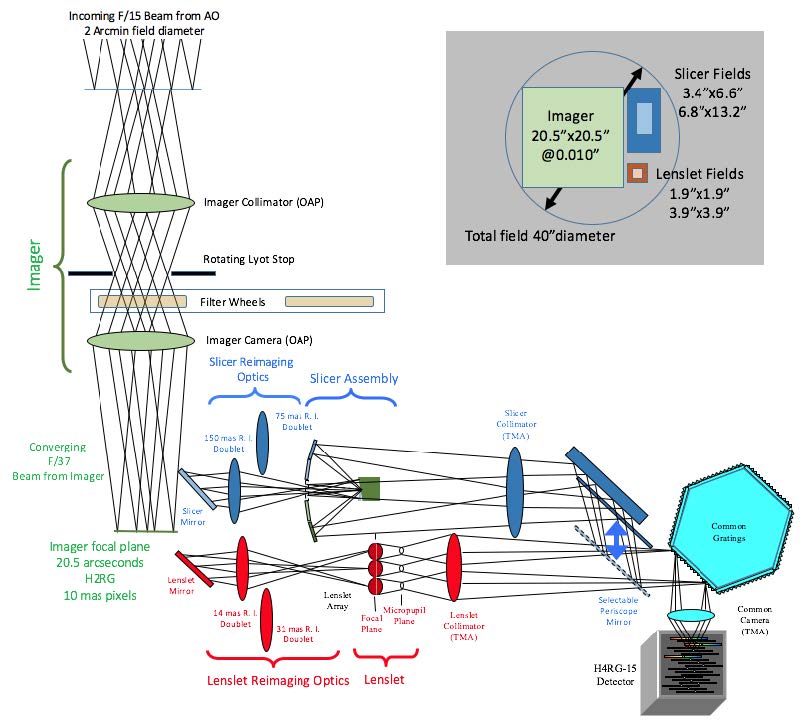
Opto-mechanical layout of the Liger imaging camera (green) and the lenslet re-imaging optics (red) and the slicer re-imaging optics (blue). The Keck AO f/15 beam is fed into Liger at the top left. The filter wheel and rotating lyot stop feeds both the imager and integral field spectrograph. There are two pick-off mirrors that can select between the slicer and lenslet IFS modes. The slicer and lenslet IFS share all complex optics like the gratings, common TMA camera, and detector (bottom right). The nominal field of view of the Liger optical system is in the top right with imaging camera (green), two spatial scales slicer IFS (blue), two spatial scales lenslet (red).
Liger Cryostat
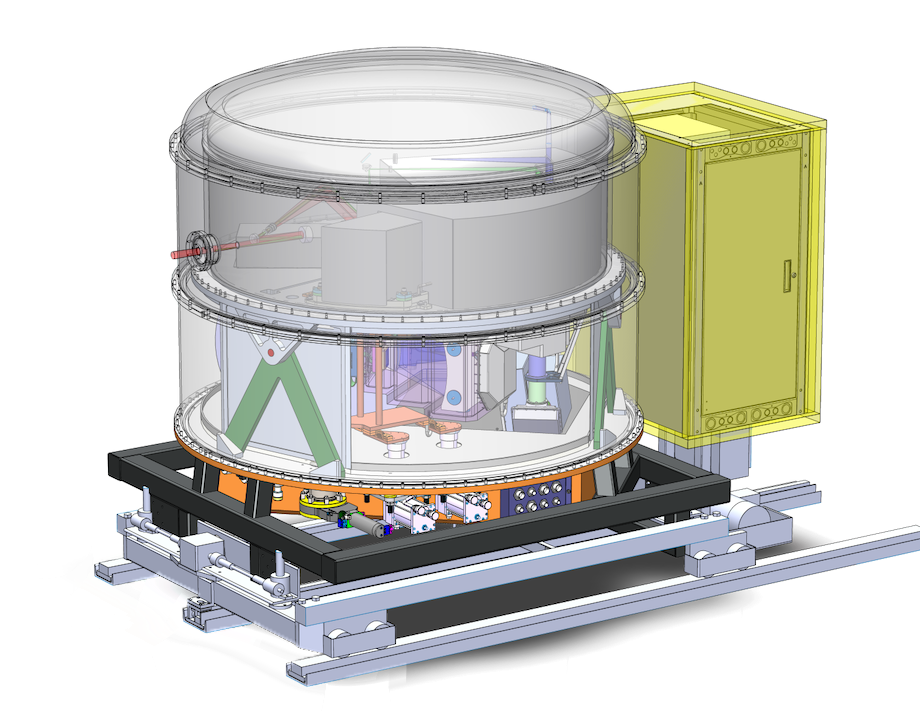
A rendering of the cylindrical Liger cryostat. The red beam from the Keck Adaptive Optics system enters on the left side. The beam is picked off at two spots on the imaging plane, one for the IFS-Slicer and one for the IFS-Lenslet. The lower white structure is the existing cart on a solid model of the Keck rail system located at the output port location of Keck AO. The electronics cabinet is depicted in yellow.
Liger Modes
| Capability Mode | Spatial Sampling (mas) | Field of View (arcseconds) | Spectral Resolution (R) | Min - Max Wavelength (μm) | Bandpass |
|---|---|---|---|---|---|
Imager |
|
|
|
|
|
Lenslet IFS |
|
|
|
|
|
Slicer IFS |
|
|
|
|
|
Liger Field of View Compared with OSIRIS
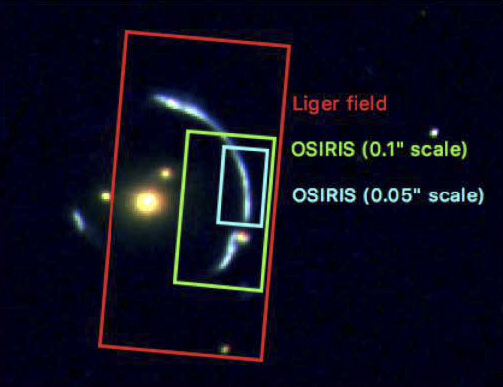
IFS observations of a z=2.01 lensed galaxy (SDSS J1206+5142, magnified ~28x by a galaxy group at z=0.42). Liger’s field of view will allow the entire arc and central lens to be observed in one pointing, whereas OSIRIS requires multiple positions even at the largest scale.
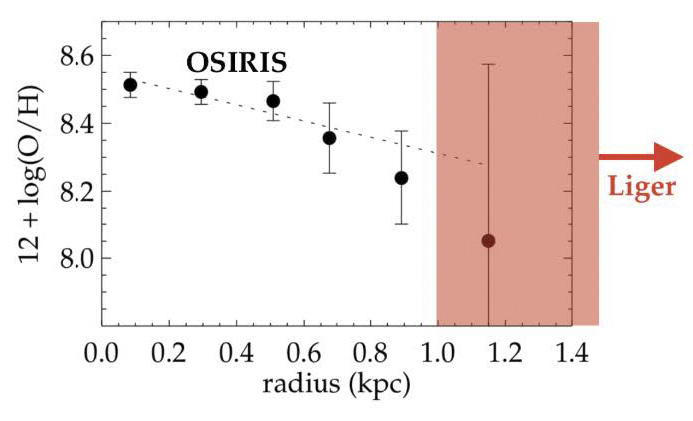
Metallicity gradient (O/H) of the lensed galaxy measured from OSIRIS data in the central R < 1 kpc, where the requisite faint emission lines are detected (Jones et al., 2013). Liger’s slicer field of view and considerably higher sensitivity will map low surface brightness emission lines at larger radii, improving gradient measurements and enabling diagnostics of shocked outflows and active galactic nuclei. Observations of similar lensed quasar systems will enable sensitive probes of dark matter substructure and dark energy, utilizing Liger’s field of view and higher spectral resolution.
Simulated Galactic Center Observations
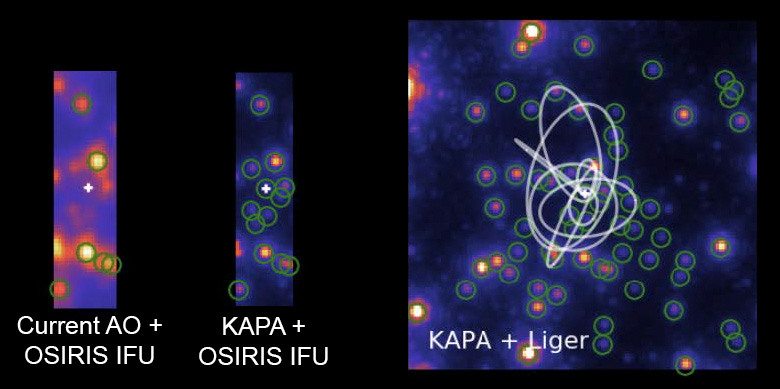
Using Liger (right) compared to OSIRIS (left). Liger’s increased field of view and sensitivity yields a dramatic increase in the number of stars with precise radial velocity measurements (indicated with green circles), including several with short-period orbits (white ellipses).
Liger Technical Team
| Name | Affiliation | Expertise |
|---|---|---|
| Aaron Brown | UCSD | Project Manager |
| Michael Biswas | UCLA | |
| Bryson Cale | UCSD | Software Engineer |
| Maren Cosens | UCSD | Graduate Student, Opto-mechanical Design and Testing |
| Michael Fitzgerald | UCLA | UCLA Co-Lead |
| Takeru Hayashi | UCLA | Software Engineer |
| Chris Johnson | UCLA | Systems Administrator |
| Tucker Jones | UCSD | Project Scientist |
| Marc Kassis | WMKO | Instrument WMKO Program Manager |
| Andrew Kramer | UCSD | |
| Evan Kress | UCLA | Mechanical Engineer |
| Renate Kupke | UCSC | UCSC Lead, Optical Design of Imager and IFS |
| James Larkin | UCLA | UCLA Lead and Co-PI |
| Nate Maguri | UCLA | |
| Ken Magnone | UCLA | Electronics |
| Rosalie McGurk | WMKO | Staff Astronomer, Onsite Integration and Commissioning |
| Jerome Maire | UCSD | Opto-Mechanical Design, Detector Testing, DRS |
| Anna Pusack | UCB | |
| Gabrielle Scott | UCSD | |
| Michael Trifoglio | UCSD | |
| Eric Wang | UCLA | Opto-Mechanical Design |
| James Wiley | UCSD | Graduate Student, Opto-Mechanical Design and Testing |
| Peter Wizinowich | WMKO | KAPA PI, Liger Performance |
| Shelley Wright | UCSD | Principal Investigator (PI) |
| Strawberry Wroolie | UCSD | |
| Sherry Yeh | WMKO | Staff Astronomer, Onsite Integration and Commissioning |
| Andrea Zonca | UCSD | Software Engineer, DRS Design |
Liger Science Team
| Name | Affiliation | Expertise |
|---|---|---|
| Lee Armus | Caltech/IPAC | |
| Devin Chu | UCLA | |
| Maren Cosens | UCSD | Nearby galaxies and HII regions |
| Mark Dickinson | NOIRLab | |
| Tuan Do | UCLA | Galactic center; supermassive black holes |
| Chris Fassnacht | UC Davis | Cosmology; dark energy and Hubble constant |
| Deanne Fisher | Swinburne | Galaxy formation and evolution |
| Michael Fitzgerald | UCLA | |
| Andrea Ghez | UCLA | Galactic center |
| Jenny Greene | Princeton | |
| Aurelien Hees | Paris Observatory | |
| Matt Hosek | UCLA | |
| Tucker Jones | UC Davis | Project Scientist, Galaxy formation and evolution |
| Theodora Karalidi | UCF | |
| Pat Kelly | Minnesota | |
| Evan Kirby | Caltech | Nearby galaxies; stellar populations |
| Quinn Konopacky | UCSD | Exoplanets; star formation |
| James Larkin | UCLA | |
| Jessica Lu | UC Berkeley | Star formation; nearby galaxies |
| Mark Marley | LPL U Arizona | |
| Anne Medling | U Toledo | |
| Max Millar-Blanchaer | UCSB | |
| Quinn Minor | BMCC | |
| Anna Nierenberg | UC Merced | |
| Anna Pusack | UC Berkeley | |
| Naveen Reddy | UC Riverside | Galaxy formation and evolution |
| Michael Rich | UCLA | |
| Jean-Baptiste Ruffio | Caltech | |
| David Sand | U Arizona | |
| Ryan Sanders | UC Davis | Galaxy formation and evolution |
| Karin Sandstrom | UCSD | Nearby galaxies; interstellar medium |
| Alice Shapley | UCLA | Galaxy formation and evolution |
| Tommaso Treu | UCLA | Cosmology; dark matter substructure |
| James Wiley | UCSD | |
| Mike Wong | UC Berkeley | Solar system; planetary science |
| Shelley Wright | UCSD |
Liger Support Members
| Name | Affiliation | Expertise |
|---|---|---|
| Amanda Cuervo | UCSD | |
| Anna Liden | UCLA | |
| Lisa Hunter | UCSC |
